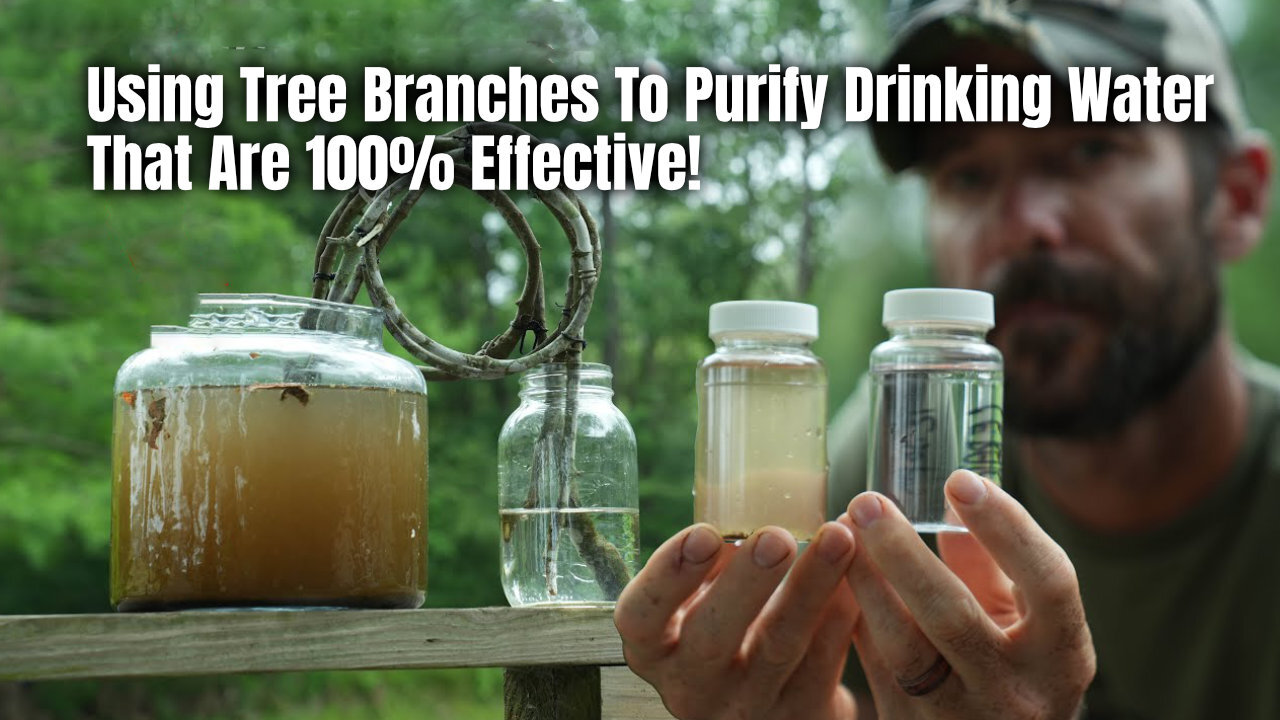Premium Only Content

Using Tree Branches To Purify Drinking Water That Are 100% Effective!
On May 18, 2024, Clay Hayes writes:
"According to the CDC, waterborne disease killed over six thousand people last year in the US alone. Waterborne pathogens such as e. coli, cryptosporidium, and giardia are prevalent in many surface water sources. There are several primitive methods for water purification including surface wells (gypsy well), boiling, and other primitive water filters which utilize some combination of course substrate, plant materials, and charcoal. I recently found a research article from MIT (link below) that showed the xylem tissue of gymnosperms effectively filtered out all bacteria from contaminated water. In this video I set up a filter using those findings but also, using a never before seen method using grape vines as both a siphon and filter in one. A lab analysis confirmed the presence of e. coli bacteria in the water to be filtered. The water that passed through the grape vines had no detectable e. coli bacteria! You can't do any better than that with the best whole house water filter. This has practical uses in backpacking, survival situations, wilderness living, camping, etc."
Original YouTube video:
https://www.youtube.com/watch?v=nSBwJNDDUfc
................
Clay Hayes Links:
Knives: https://www.montanaknifecompany.com/
Backpacks: kifaru.net/CLAYHAYES
Archery Gear: https://www.3riversarchery.com/
Optics: https://www.vortexoptics.com
Clothing: https://www.firstlite.com/
Camera Gear: https://amzn.to/47HZFrz
Essential Backcountry Gear: https://amzn.to/3u6H0If
Surviving Alone by Clay Hayes: https://amzn.to/3Qqou3l
Website: https://www.twistedstave.com/
Facebook: clayhayeshunter
Instagram: clayhayeshunter
Patreon: clayhayes
................
MIT Engineers Make Filters From Tree Branches To Purify Drinking Water
By Jennifer Chu
MIT News Office
March 25, 2021
https://news.mit.edu/2021/filters-sapwood-purify-water-0325
The interiors of nonflowering trees such as pine and ginkgo contain sapwood lined with straw-like conduits known as xylem, which draw water up through a tree’s trunk and branches. Xylem conduits are interconnected via thin membranes that act as natural sieves, filtering out bubbles from water and sap.
MIT engineers have been investigating sapwood’s natural filtering ability, and have previously fabricated simple filters from peeled cross-sections of sapwood branches, demonstrating that the low-tech design effectively filters bacteria.
Now, the same team has advanced the technology and shown that it works in real-world situations. They have fabricated new xylem filters that can filter out pathogens such as E. coli and rotavirus in lab tests, and have shown that the filter can remove bacteria from contaminated spring, tap, and groundwater. They also developed simple techniques to extend the filters’ shelf-life, enabling the woody disks to purify water after being stored in a dry form for at least two years.
The researchers took their techniques to India, where they made xylem filters from native trees and tested the filters with local users. Based on their feedback, the team developed a prototype of a simple filtration system, fitted with replaceable xylem filters that purified water at a rate of one liter per hour.
Their results, published today in Nature Communications, show that xylem filters have potential for use in community settings to remove bacteria and viruses from contaminated drinking water.
The researchers are exploring options to make xylem filters available at large scale, particularly in areas where contaminated drinking water is a major cause of disease and death. The team has launched an open-source website, with guidelines for designing and fabricating xylem filters from various tree types. The website is intended to support entrepreneurs, organizations, and leaders to introduce the technology to broader communities, and inspire students to perform their own science experiments with xylem filters.
“Because the raw materials are widely available and the fabrication processes are simple, one could imagine involving communities in procuring, fabricating, and distributing xylem filters,” says Rohit Karnik, professor of mechanical engineering and associate department head for education at MIT. “For places where the only option has been to drink unfiltered water, we expect xylem filters would improve health, and make water drinkable.”
Karnik’s study co-authors are lead author Krithika Ramchander and Luda Wang of MIT’s Department of Mechanical Engineering, and Megha Hegde, Anish Antony, Kendra Leith, and Amy Smith of MIT D-Lab.
Clearing the way
In their prior studies of xylem, Karnik and his colleagues found that the woody material’s natural filtering ability also came with some natural limitations. As the wood dried, the branches’ sieve-like membranes began to stick to the walls, reducing the filter’s permeance, or ability to allow water to flow through. The filters also appeared to “self-block” over time, building up woody matter that clogged the conduits.
Surprisingly, two simple treatments overcame both limitations. By soaking small cross-sections of sapwood in hot water for an hour, then dipping them in ethanol and letting them dry, Ramchander found that the material retained its permeance, efficiently filtering water without clogging up. Its filtering could also be improved by tailoring a filter’s thickness according to its tree type.
The researchers sliced and treated small cross-sections of white pine from branches around the MIT campus and showed that the resulting filters maintained a permeance comparable to commercial filters, even after being stored for up to two years, significantly extending the filters’ shelf life.
The researchers also tested the filters’ ability to remove contaminants such as E. coli and rotavirus — the most common cause of diarrheal disease. The treated filters removed more than 99 percent of both contaminants, a water treatment level that meets the “two-star comprehensive protection” category set by the World Health Organization.
“We think these filters can reasonably address bacterial contaminants,” Ramchander says. “But there are chemical contaminants like arsenic and fluoride where we don’t know the effect yet,” she notes.
Groundwork
Encouraged by their results in the lab, the researchers moved to field-test their designs in India, a country that has experienced the highest mortality rate due to water-borne disease in the world, and where safe and reliable drinking water is inaccessible to more than 160 million people.
Over two years, the engineers, including researchers in the MIT D-Lab, worked in mountain and urban regions, facilitated by local NGOs Himmotthan Society, Shramyog, Peoples Science Institute, and Essmart. They fabricated filters from native pine trees and tested them, along with filters made from ginkgo trees in the U.S., with local drinking water sources. These tests confirmed that the filters effectively removed bacteria found in the local water. The researchers also held interviews, focus groups, and design workshops to understand local communities’ current water practices, and challenges and preferences for water treatment solutions. They also gathered feedback on the design.
“One of the things that scored very high with people was the fact that this filter is a natural material that everyone recognizes,” Hegde says. “We also found that people in low-income households prefer to pay a smaller amount on a daily basis, versus a larger amount less frequently. That was a barrier to using existing filters, because replacement costs were too much.”
With information from more than 1,000 potential users across India, they designed a prototype of a simple filtration system, fitted with a receptacle at the top that users can fill with water. The water flows down a 1-meter-long tube, through a xylem filter, and out through a valve-controlled spout. The xylem filter can be swapped out either daily or weekly, depending on a household’s needs.
The team is exploring ways to produce xylem filters at larger scales, with locally available resources and in a way that would encourage people to practice water purification as part of their daily lives — for instance, by providing replacement filters in affordable, pay-as-you-go packets.
“Xylem filters are made from inexpensive and abundantly available materials, which could be made available at local shops, where people can buy what they need, without requiring an upfront investment as is typical for other water filter cartridges,” Karnik says. “For now, we’ve shown that xylem filters provide performance that’s realistic.”
This research was supported, in part, by the Abdul Latif Jameel Water and Food Systems Lab (J-WAFS) at MIT and the MIT Tata Center for Technology and Design.
................
See also:
Clean Water Out Of Thin Air
https://www.sunfellow.com/clean-water-out-of-thin-air/
Sunfellow Preparedness
https://rumble.com/c/sunfellowpreparedness
Preparedness, Self-Sufficiency, Living Off The Grid
https://rumble.com/playlists/V_xAnHUGy_Y
-
 5:22
5:22
Sunfellow Preparedness
5 months agoEarth's Magnetic Poles Could Flip Between 2030 To Late 2040s Setting Off Catastrophic Changes
2771 -
 9:11
9:11
Faith Frontline
13 hours agoTucker Carlson SHOCKED As Cliffe Knechtle Reveals God’s Chosen People
2.1K4 -
 23:10
23:10
Jasmin Laine
16 hours agoCTV Host Visibly UNCOMFORTABLE As Guest Calls Canadians RACIST—Poilievre Leaves Them SPEECHLESS
3.69K4 -
 20:18
20:18
Fit'n Fire
16 hours ago $0.29 earned*NEW* CZ P10C OR Ported -- First 500 Rounds
2.29K1 -
 14:41
14:41
Nate The Lawyer
1 day ago $0.66 earnedWhy Hasn’t Raja Jackson Been Arrested Yet?
4.04K14 -
 6:04
6:04
Buddy Brown
2 days ago $1.21 earnedEugene’s SICK Newspaper Cover is a WARNING to Us All! | Buddy Brown
6.99K9 -
 16:23
16:23
Actual Justice Warrior
1 day agoMom Sucker Punched By Repeat Offender In Chicago
11K30 -
 56:28
56:28
Professor Nez
1 day ago🚨Not Only is Epstein NOT Going Away… It Just Got Worse!
25K25 -
 8:09
8:09
MattMorseTV
18 hours ago $11.19 earnedTrump scores 17th CONSECUTIVE Supreme Court VICTORY.
76.7K60 -
 2:11:25
2:11:25
Side Scrollers Podcast
20 hours agoUK JAILS TV WRITER FOR WRONG THINK + TWITCH ALLOWS CYBERSTALKING + MORE | SIDE SCROLLERS LIVE
34.9K10